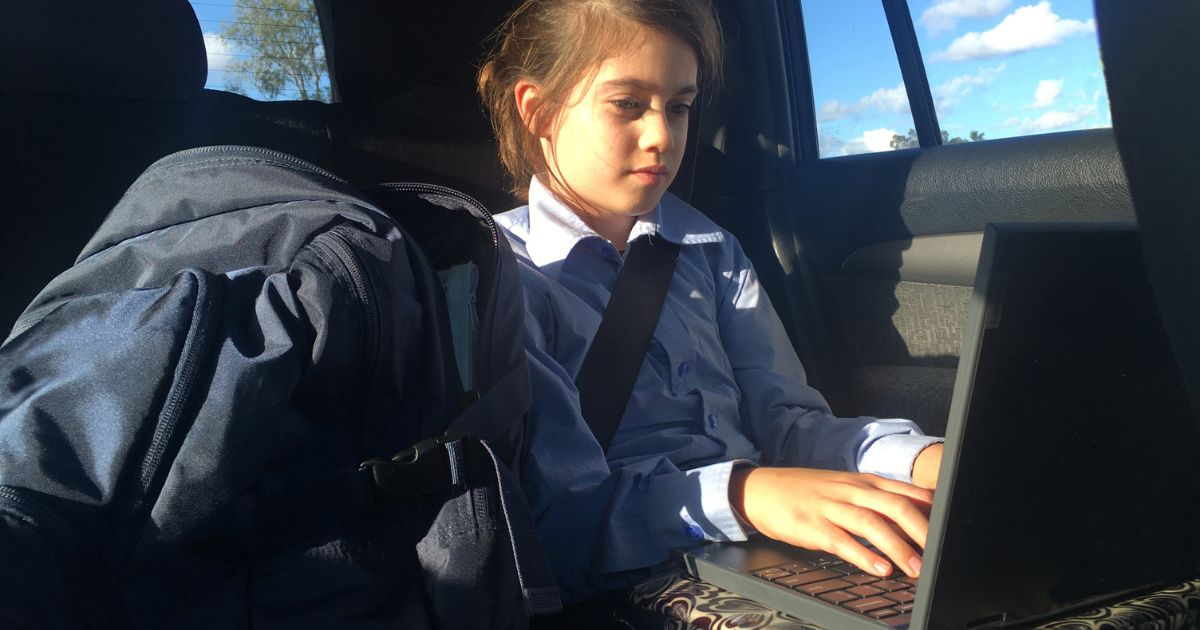Ever dreamed of swapping your homeschool room for a scenic mountain view or a beachside picnic table? Homeschooling on the road—also known as “roadschooling”—makes that dream possible. It’s the ultimate blend of learning and adventure. You can explore history where it happened, study ecosystems in real life, and turn every mile into a lesson. But before you pack the minivan and hit the highway, a bit of prep work goes a long way. Let’s dive into the essentials, tips, and tricks to help your mobile classroom run as smoothly as your wheels.
The Basics of Homeschooling on the Road
Roadschooling is exactly what it sounds like—teaching your kids while traveling. It can be full-time or just during long trips or vacations. Some families sell everything and live in an RV, while others plan seasonal adventures between home-based learning.
The beauty of this lifestyle is flexibility. You can tailor education to your journey—learning about geology while hiking a canyon or studying marine life near the coast. But with that freedom comes responsibility: structure, organization, and intentional learning.
Here are a few key ideas to keep in mind:
- Set learning goals early. You’ll want to stay aligned with your homeschool requirements or curriculum.
- Plan around destinations. Use travel as an educational asset—national parks, historical landmarks, and museums are goldmines.
- Stay adaptable. Things won’t always go to plan (storms, Wi-Fi issues, car trouble), and that’s part of the learning journey.
Roadschooling Tips for Staying Organized
Travel can make life feel unpredictable, so finding a rhythm that works for your family is essential. These roadschooling tips will help you stay on track while keeping the fun alive.
- Establish a Routine—but Keep It Loose
A structured routine gives everyone a sense of normalcy. Try dedicating certain hours to lessons, but don’t cling to a rigid schedule. Maybe math happens before breakfast some days, or reading happens during long drives. Find your family’s natural flow.
- Go Digital Where You Can
Paperwork can pile up fast when space is tight. Digital tools are your best friend.
- Use apps like Notion, Google Classroom, or Trello to track assignments.
- Store books and worksheets on tablets or e-readers.
- Keep offline versions of key materials for times without internet access.
- Make Learning Location-Based
One of the biggest perks of homeschooling on the road is hands-on education.
- Studying history? Visit battlefields or pioneer museums.
- Learning about geography? Compare landscapes across states.
- Covering biology? Explore tide pools or nature preserves.
These experiences make learning unforgettable.
- Prioritize Connection Time
Between travel days, lessons, and sightseeing, downtime is crucial. Schedule family reading nights or campfire chats to reflect on what everyone’s learned. It helps reinforce lessons and keeps your bond strong.

Homeschool Travel Essentials You Shouldn’t Leave Without
Packing for homeschool travel isn’t just about clothes and snacks—it’s about setting yourself up for smooth, successful learning wherever you go. Here’s what you’ll want on your checklist:
Tech and Learning Tools
- Laptops or tablets: Choose durable ones that can handle a bit of road wear.
- Wi-Fi hotspot: Not every campsite has reliable internet.
- Power bank: For charging on the go.
- Noise-canceling headphones: A lifesaver for focus in crowded spaces.
Educational Materials
- Core curriculum resources: Digital or print, depending on your style.
- Portable whiteboard and markers: Great for quick lessons or visual learners.
- Field notebooks: Perfect for journaling, sketching, and note-taking.
- Books: A mix of leisure reads and educational materials.
Travel and Comfort Items
- Storage bins: Keep school materials organized and easy to grab.
- Clipboards and lap desks: Make any spot a workspace.
- Reusable water bottles and snacks: Learning (and traveling) runs on fuel.
- First aid kit: Because adventure sometimes comes with scraped knees.
Bonus Items for Creative Learning
- Art supplies (watercolors, sketchpads, colored pencils)
- Nature identification books
- Travel games that double as learning tools
- Audio lessons or podcasts for drive time
Creating Your Mobile Homeschool Routine
Your mobile homeschool guide doesn’t need to look like a traditional school schedule. In fact, it shouldn’t. The goal is balance—learning woven into your travel lifestyle.
Here’s a sample day for inspiration:
- Morning (8:00–10:00 AM): Core subjects like math or language arts before hitting the road.
- Midday (10:30–1:00 PM): Travel time or destination-based lessons (visiting a museum, hiking trail, or landmark).
- Afternoon (1:00–4:00 PM): Journaling, creative writing, or science projects.
- Evening (After 5:00 PM): Free time, family reflection, or reading.
You can adjust based on your travel plans, kids’ energy levels, and weather. Remember—learning doesn’t just happen with textbooks. It’s in the conversations, the detours, and the unexpected moments that spark curiosity.
Dealing with Challenges on the Road
Let’s be real—homeschooling on the road sounds magical, but there will be bumps (literally and figuratively). The key is preparation and flexibility.
Common hurdles include:
- Wi-Fi issues: Download lessons ahead of time or carry offline materials.
- Limited space: Go minimal—store only what you’ll truly use.
- Burnout: Schedule rest days and limit screen time.
- Record keeping: Use digital tools to store grades, attendance, and notes.
When challenges pop up, remember that these are life lessons too. Kids learn resilience, adaptability, and creative problem-solving—all invaluable skills.
How to Make Every Trip Educational
Sometimes, the best lessons aren’t planned. Here’s how to make every journey count:
Embrace “Teachable Moments”
Turn unexpected experiences into learning opportunities. Got lost? Talk about navigation and map reading. Encountered wildlife? Discuss ecosystems. Missed a ferry? Practice patience and adaptability.
Keep a Family Travel Journal
Have each child write or draw about their experiences. It’s a fun keepsake and a sneaky way to include writing, spelling, and reflection.
Connect with Local Communities
Meet local homeschooling groups or visit community centers. Your kids can make friends, and you can exchange tips with other traveling parents.
Three Big Mindset Shifts for Roadschooling Parents
This section’s just for you, the grown-ups behind the wheel (and the lesson plans). Here are a few mindset shifts that can make all the difference.
- Progress over perfection. Some days will feel wildly productive. Others might feel like a wash. That’s okay. Focus on the big picture of growth and discovery.
- Learning happens everywhere. Even a grocery run in a new state can turn into a geography or budgeting lesson.
- Flexibility is your superpower. Roadschooling thrives on your ability to pivot—whether that’s changing destinations or adapting a lesson mid-drive.
Planning Your Route Around Learning
While spontaneity is part of the fun, having an educational route in mind can help maximize your adventures. Consider mapping stops that align with your subjects for the year.
- History buffs? Trace the Revolutionary War or Route 66.
- Nature lovers? Visit national parks or geological wonders.
- Science enthusiasts? Check out observatories, space centers, or natural history museums.
Use resources like the National Park Service’s Junior Ranger Program—an amazing hands-on way to connect learning with real-world exploration.
Why Kids Thrive with Homeschooling on the Road
Beyond the academics, this lifestyle builds independence, adaptability, and curiosity. Kids see diverse cultures, landscapes, and communities firsthand. They learn that the world is both vast and connected.
They also develop time management, communication, and self-guided learning skills because roadschooling encourages ownership of their education. Every trip becomes a story they helped write.
Keep the Learning Journey Rolling
If you’re feeling the pull toward life on the open road, take it as your cue to start planning. You don’t need to sell everything or go full nomad mode—just start small. Take a weekend trip, test your mobile setup, and see how your family adapts.
The goal isn’t to make homeschooling on the road perfect—it’s to make it meaningful. Whether you’re chasing sunshine, following history, or just craving a change of scenery, remember that every mile can bring a new kind of learning.
Keep Exploring with DKM Homeschool Resource
Your homeschooling journey doesn’t stop here. Browse more of our blogs for practical homeschool advice, creative lesson ideas, and family travel tips to keep your kids learning wherever life takes you. Adventure and education go hand in hand—and we’re here to help you make the most of both.




